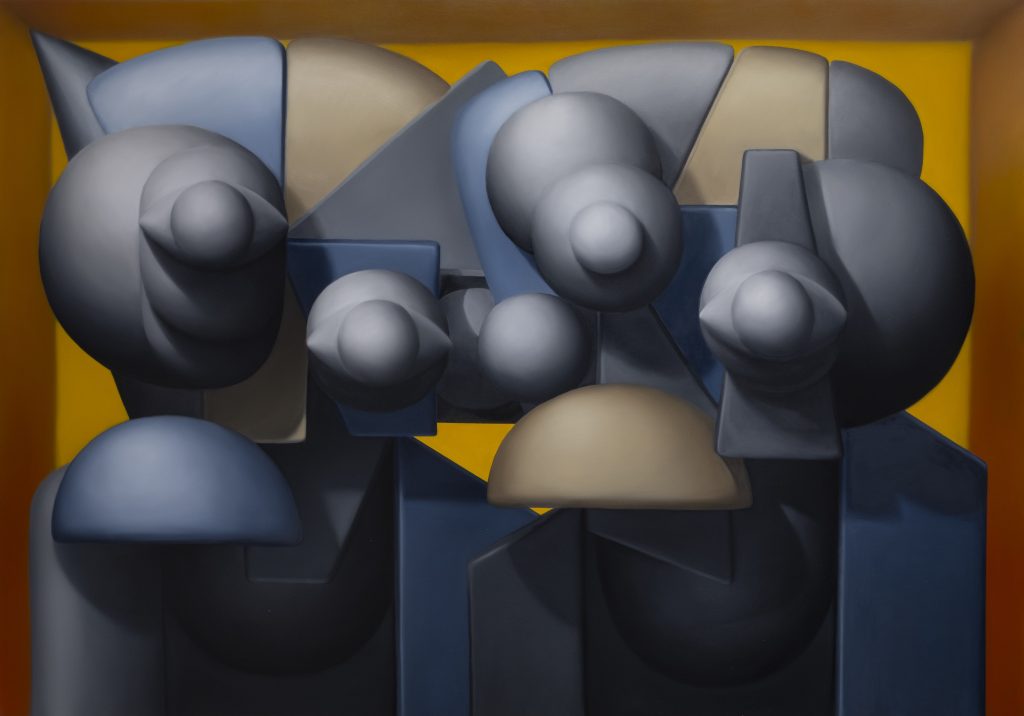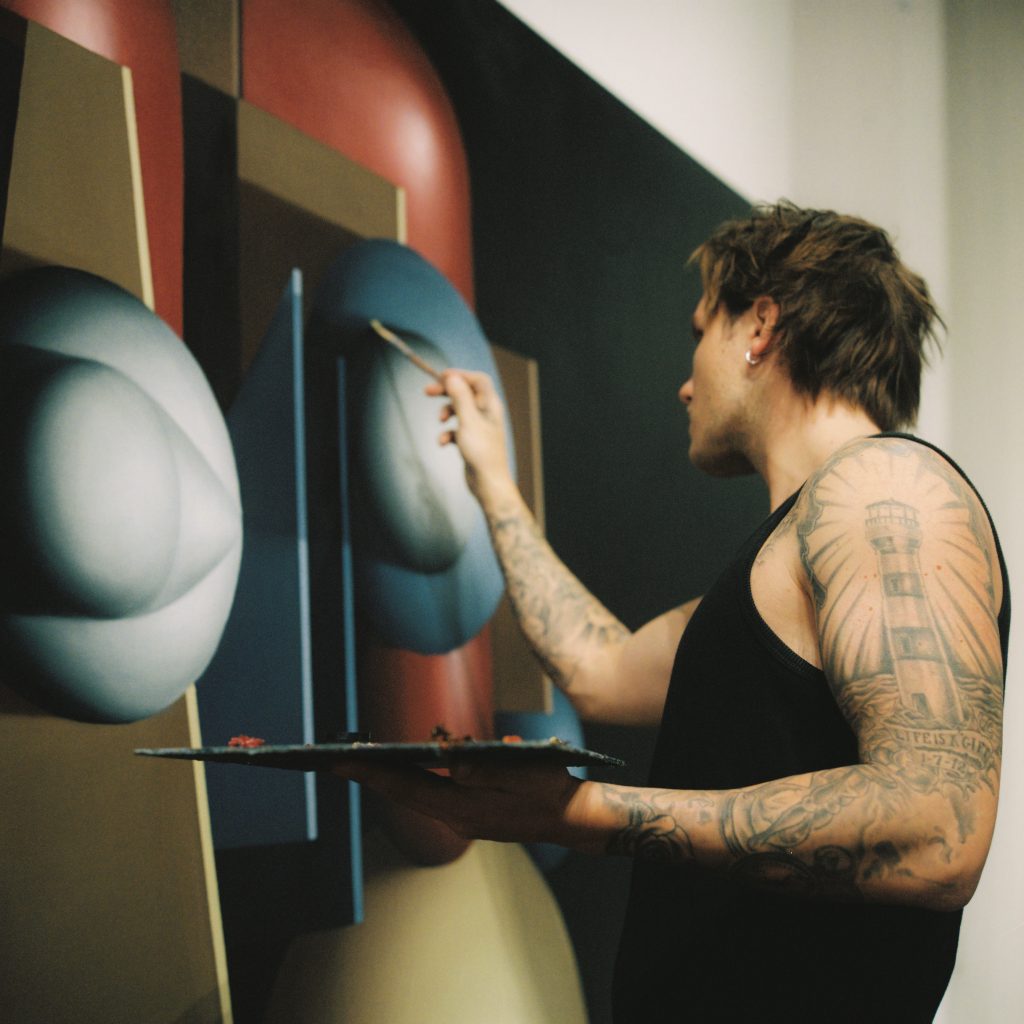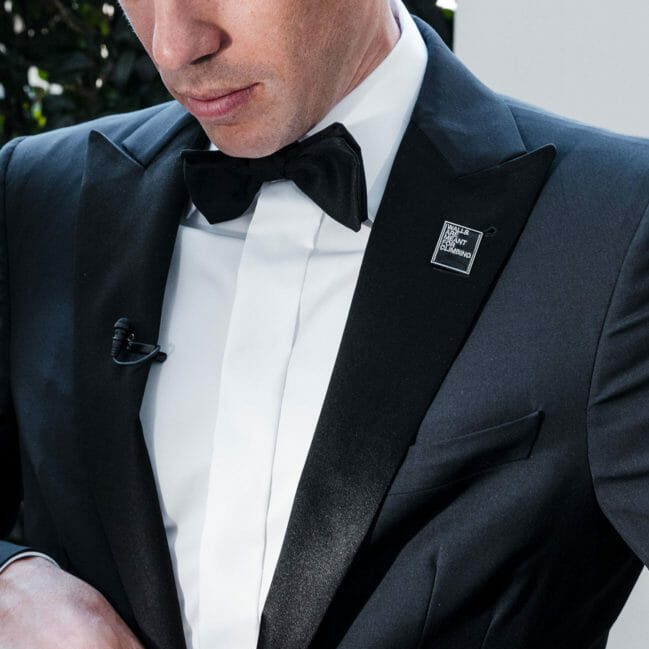Devon DeJardin’s “Giants” Exhibit Brings New Perspective to the Insurmountable
Immense and introspective portraits populate the fine artist’s first solo show in NYC

Portland, Oregon-born Devon DeJardin started painting after a proposition from an alleged sugar daddy. The man, over Instagram messages, offered to pay DeJardin if he spoke with him over the phone—the artist reluctantly consented. “I know this might sound weird,” the man said to him, “but are you into spirituality?” Approaching the end of his four years of studying theology at university, DeJardin, now very intrigued, confirmed that he is indeed spiritual. “I’ve been following you for a while, and I think God or whatever you believe is telling me to tell you to start painting,” the man continued. That same day, DeJardin, who had never picked up a paintbrush before, went to the store and bought a canvas and acrylics and began painting. Now, he’s presenting his first solo gallery show, entitled Giants, at New York City’s Albertz Benda.

On view tomorrow, 30 June, until 5 August, Giants delves into the artist’s fascination with the spiritual, featuring immense and immersive portraits (as well as two sculptures) of non-theological symbols of protection, which DeJardin refers to as Guardians. As the name of the show suggest, DeJardin’s latest hyperrealistic and cubist pieces are momentous, seeming as if the characters could leap off the canvas. Previously seen as solitary figures, in this solo show the Guardians are in conversation with one another, amounting to a narrative-driven and introspective exhibition on growth, strength and the challenges behind it.

The inspiration for Giants came from Malcolm Gladwell’s book David and Goliath: Underdogs, Misfits, and the Art of Battling Giants, in which Gladwell explains why underdogs win in situations where the odds are stacked against them, using David and Goliath as his primary example. “I always loved that story because so often in life we face challenges and we face these kinds of symbolic giants,” DeJardin explains. “We’re always so intimidated by what’s right in front of us, but we don’t really take the time to sit back and look at it from a different angle and realize that we often can have a greater advantage.”

Challenging the seemingly insurmountable is a theme that permeates the whole show. In “Giants are not what we think they are,” one enormous figure towers over another. Yet, the painting “In Passing,” repositions these same figures to become equal in stature. Similarly, when viewers step up to the portraits, the works feel monumental in size and impression, as if the spectators are facing off with their own giant. Through this overwhelming sense, DeJardin encourages others to examine the giants in their own life to ascertain how they may not be as impossible as previously thought.

Working on the Guardians led to rumination for the self-taught artist. “It’s been a good point of reflection to look back at times in my life where I felt I needed to step through certain hurdles and challenges and understand what are these physical giants in my life that are going to continue to cause pain or cause struggle that I need to ultimately defeat in order to see the brighter light,” he continues. “For me, the exhibition is trying to start the conversation for the viewers to be able to ask those questions in their life.”

If the exhibit asks, “What giants or challenges do you need to overcome?” then it also begs the question, “What obstacles have you already conquered?” The merging of past and present is seen within the exhibit’s source material itself, as DeJardin notes how Gladwell references a story from the past to retell it in a present sense. A dual sense of time was integral to the artist, whose work often blends temporalities. He tells us, “I’ve always said that good art really needs to touch on the past, have a finger on present and then also point the viewer toward the future. For me, we moved into this hyper-digital age all of a sudden with the metaverse and NFTs. It was all around me, and I wanted them to push the painting in a parallel path, so the paintings themselves are very, very sharp and clean. They kind of feel like they may have been created digitally.”

While clean, layered geometry might afford the paintings modern sensibilities, DeJardin turned to old-school techniques for oil painting, getting more technical with this exhibit than any previous. He starts with a loose sketch that he’ll do on any paper on hand be it napkins or scraps. Then, he moves to a small form study of oil on paper and once the colors and layout are right, he transfers them onto the computer to manipulate color and modes of painting. Once he has the right components, he prints out the sketch to use as a rough draft to start painting the canvas. The process takes months to complete for each piece.

Sculpture is a newer medium for the artist. For the show, DeJardin crafted two: a four-foot-tall brass figure and a six-foot-tall bronze statue, that acts as the show’s centerpiece. “I wanted to move into bringing a kind of life off of the canvas, where I’ve pushed the oil painting to a degree in the show where people are like, ‘Wow, it seems like it’s coming off the canvas,'” he says.

Although the portraits themselves immediately draw the eye with their layered composition and deep hues, DeJardin tells us not to overlook the backdrop: “In some of the paintings, you’ll start to see that there is what kind of looks like a world being created around the portraits, and some of the paintings have these ethereal backgrounds and these perspective changes where you can see depth and rooms and light sources coming in. It’s kind of a preview and a hint of what’s to come in future exhibitions.”

Featuring towering and thought-provoking works, Giants confronts what feels insurmountable and dares viewers to do the same. The exhibition expands DeJardin’s 3D-like portraiture and prowess at crafting a vast presence from oil on canvas.
Images by David Katzinger, courtesy of the artist












